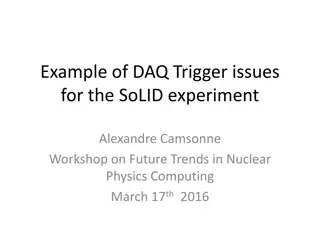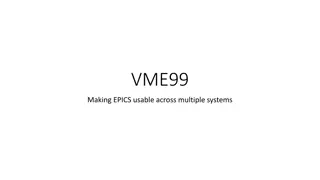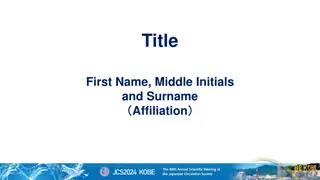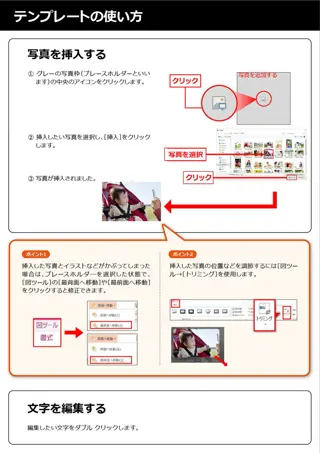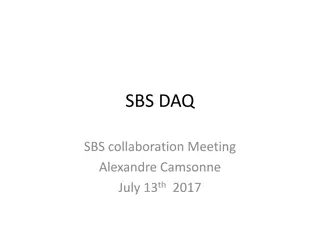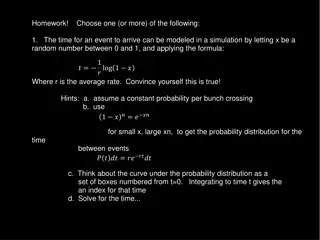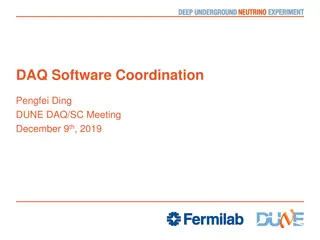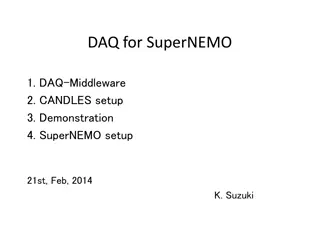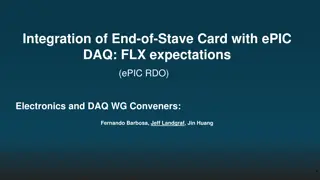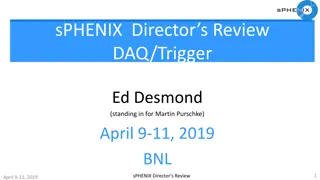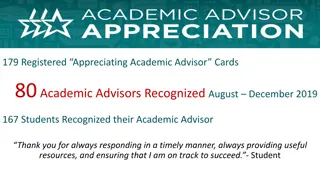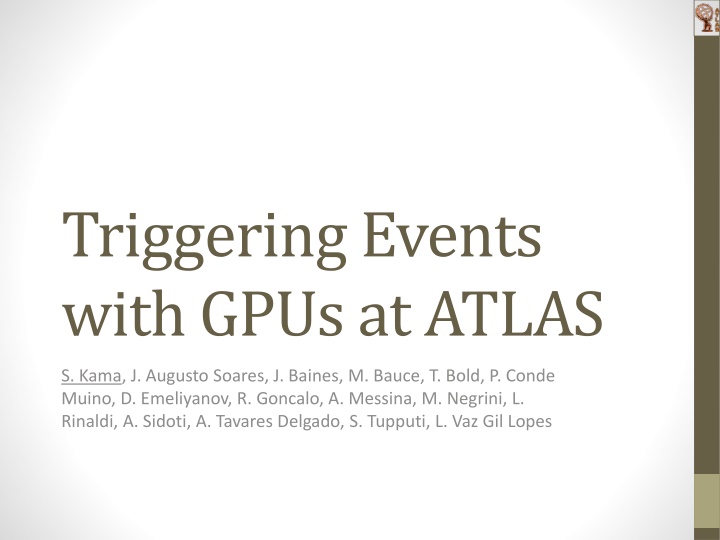
GPU Demonstrator for Increased LHC Instantaneous Luminosity
"Learn how ATLAS is utilizing GPU technology to handle higher pileup and boost throughput in the Inner Detector, Calorimeters, and Muons Tracking. Discover the benefits and potential cost-effectiveness of GPUs in enhancing performance at the ATLAS experiment."
Download Presentation

Please find below an Image/Link to download the presentation.
The content on the website is provided AS IS for your information and personal use only. It may not be sold, licensed, or shared on other websites without obtaining consent from the author. If you encounter any issues during the download, it is possible that the publisher has removed the file from their server.
You are allowed to download the files provided on this website for personal or commercial use, subject to the condition that they are used lawfully. All files are the property of their respective owners.
The content on the website is provided AS IS for your information and personal use only. It may not be sold, licensed, or shared on other websites without obtaining consent from the author.
E N D
Presentation Transcript
Triggering Events with GPUs at ATLAS S. Kama, J. Augusto Soares, J. Baines, M. Bauce, T. Bold, P. Conde Muino, D. Emeliyanov, R. Goncalo, A. Messina, M. Negrini, L. Rinaldi, A. Sidoti, A. Tavares Delgado, S. Tupputi, L. Vaz Gil Lopes
ATLAS Trigger and DAQ 3/18/2025 Composed of hardware based Level-1 (L1) and software based High Level Trigger(HLT) Reduces 40MHz input event rate to about 1kHz ( ~1500MB/s output) L1 identifies interesting activity in small geometrical regions of detector called Region of Interests (RoI) RoIs identified by L1 are passed to the HLT for event selection S.Kama CHEP 2015, Okinawa See R.Hauser s talk With about 25k processes ~25k/100kHz = ~250ms/Event decision time 2
High Level Trigger 3/18/2025 HLT uses Stepwise processing of sequences called Trigger Chains(TC) Each chain is composed of Algorithms and seeded by RoIs from L1 Same RoI may seed multiple chains Same Algorithm may run on different data An algorithm runs only once on same data (caching) If a RoI fails a selection step further algorithms in chain are not executed Initial algorithms (L2) work on partial event data (2-6%). Later algorithms have access to full event data L1 ROI L1 ROI L1 ROI L2 Alg L2 Alg L2 Alg L2 Alg L2 Alg L2 Alg L2 Alg L2 Alg L2 Alg L2 Alg L2 Alg L2 Alg S.Kama CHEP 2015, Okinawa L2 Alg L2 Alg L2 Alg L2 Alg Event Building EF Alg EF Alg EF Alg EF Alg EF Alg EF Alg EF Alg EF Alg EF Alg EF Alg EF Alg EF Alg EF Alg EF Alg EF Alg EF Alg EF Alg EF Alg EF Alg EF Alg 3
Inner Detector and Calorimeters 3/18/2025 Inner detector houses trackers and composed of Pixel detector Silicon strip detector (SCT) Transition Radiation Tracker (TRT) Calorimeters contain electromagnetic and hadronic components and composed of Liquid Argon (LAr) Tile Calorimeters S.Kama CHEP 2015, Okinawa 4
GPU Demonstrator 3/18/2025 Increasing LHC instantaneous luminosity is leading to higher pileup CPU time rises rapidly with pile-up due to combinatorial nature of the tracking HLT farm size is limited, mainly by power and cooling ATLAS is developing and expanding demonstrator exploiting GPUs in: Inner Detector-Tracking Calorimeter-Topo-clustering Muons-Tracking to evaluate the potential benefit of GPUs in terms of throughput per unit cost Tracks from primary interaction and pileup interaction vertices S.Kama CHEP 2015, Okinawa GPUs provide good power/compute ratio During Run-1, ID only demonstrator has shown good speedup (up to 12x)* *ATL-DAQ-SLIDE-2014-635 5
Offloading Mechanism Trigger Processing Units integrate ATLAS offline software framework, ATHENA, to online environment Many PU processes run on each Trigger host A client-server approach is implemented to manage resources between multiple PU processes. PU prepares data to be processed and sends it to server Accelerator Process Extension (APE) Server manages offload requests and executes kernels on GPU(s) It sends results back to process that made the offload request 3/18/2025 Trigger PU (ATHENA) (ATHENA) (ATHENA) (ATHENA) Data+Metadata Trigger PU Trigger PU Trigger PU Results+Metadata APE Server S.Kama CHEP 2015, Okinawa Server can support different hardware types (GPUs, Xeon-Phi, CPUs) and different configurations such as GPU/Phi mixtures and in-host off-host accelerators. 6
Offloading - Client Implemented for each detector such as TrigInDetAccelSvc 3/18/2025 1. HLT Algorithm asks for offload to TrigDetAccelSvc TrigDetAccelSvc converts C++ classes for raw and reconstructed quantities from the Athena Event Data Model(EDM) to GPU optimized EDM through Data Export Tools Then it adds metadata and requests offload through OffloadSvc OffloadSvc manages multiple requests and communication with APE server Results are converted back to Athena EDM by TrigDetAccelSvc and handed to requesting algorithm HLT Algoritm 5 2. Athena EDM 1 Data+MetaData TrigDetAccelSvc OffloadSvc 3 2 GPU EDM S.Kama CHEP 2015, Okinawa Request Result Export Tool Export Tool 4 3. 4. Export tools and server communication need to be fast (serial sections) APE Server 5. 7
Offloading - Server 3/18/2025 APE Server uses plug-in mechanism It is composed of Manager handles communication with processes and scheduling Receives offload requests Passes the request to appropriate module Executes Work items Sends the results back to requesting process Modules manage GPU resources and create work items Manage constants and time-varying data on GPU Bunch multiple requests to optimize utilization Create appropriate work items Work items run GPU kernels such as clusterization on given data and prepare results Each detector implements their own module Athena Work Data + Metadata Module Todo Queue S.Kama CHEP 2015, Okinawa APE Server Completed Queue Athena Results + Metadata 8
ID Module 3/18/2025 Tracking is most time consuming part of trigger ID module implements several CPU intensive steps on GPU Bytestream decoding converts detector encoded output to hits on Pixel and SCT modules Charged particles typically activate one or more neighboring strips or pixels. Hit clustering merges these by a Cellular Automata algorithm ByteStream Decoding Hit Track Formation Clone Reomval Clustering S.Kama CHEP 2015, Okinawa Each thread works on a word and decodes it. Data contains hits on different modules on different ID layers Each hit start as an independent cluster. Adjacent clusters are merged in each step until all adjacent cells belong to same cluster. Each thread works on a different hit 9
ID Tracking 3/18/2025 Tracking starts with pair forming. A 2-D thread array checks for pairing condition and selects suitable pairs S.Kama CHEP 2015, Okinawa Then these pairs are extrapolated to outer layers by a 2D thread block to form triplets. Finally triplets are combined to form Track Candidates. In clone removal step, track candidates starting from different pairs but having same outer layer hits are merged to form tracks 10
ID Speedup 3/18/2025 Raw detector data decoding and clusterization algorithms form the first step of reconstruction(data preparation) Initial tests with Monte- Carlo samples shown up to 21x speed up compared to serial Athena job. A new upgraded tracking algorithm is being implemented S.Kama CHEP 2015, Okinawa Up to 21x 11
Calorimeter Topoclustering Topocluster algorithm classifies calorimeter cells by signal/noise S/N>4 are Seeds 4>S/N>2 are Growing cells 2>S/N>0 are Terminal cells Growing cells around Seeds are included until they don t have any more Growing or Terminal cells around them Parallel implementation uses Cellular Automata algorithm to parallelize the task Implementation is underway 3/18/2025 S.Kama CHEP 2015, Okinawa Parallel algorithm Standard algorithm 1. Assign one thread for each cell 2. Start with adding Seeds to cluster. 3. At each iteration join to the cluster which contain highest S/N neighboring cell 4. Terminate when maximum radius is reached or can t include anymore cells 12
Next Steps 3/18/2025 Finalize porting of ID track finding and clone removal algorithms Finalize and include Calorimeter Topoclustering module Implement and include Muon tracking module Make detailed measurements including throughput per unit cost by the end of the year and use this to estimate potential benefit in future HLT farm S.Kama CHEP 2015, Okinawa 13
Summary & Outlook Increasing instantaneous luminosity of LHC necessitates parallel processing Massive parallelization of trigger algorithms on GPU is being investigated as a way to increase the compute- power of the HLT farm ATLAS developed APE framework to manage offloading from multiple processes Inner detector Trigger data preparation algorithms are successfully offloaded to GPU, resulting in ~21x speedup compared to CPU implementations Further algorithms for ID, Calorimeter and Muon systems are being implemented. 3/18/2025 S.Kama CHEP 2015, Okinawa 14
3/18/2025 THANK YOU S.Kama CHEP 2015, Okinawa 15
3/18/2025 S.Kama CHEP 2015, Okinawa BACKUPS 16
Architectural Design 3/18/2025 S.Kama CHEP 2015, Okinawa 17
Implementation 3/18/2025 S.Kama CHEP 2015, Okinawa 18




